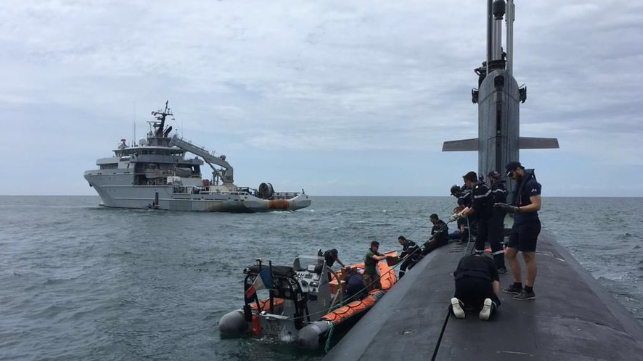Naval ambitions come as part of EU’s strategy to extend its Asian reach and counter the rise of China.
Brussels/Washington/Paris (18/4- 28.57). Politico reports that the EU is on Monday set to commit to a “meaningful” naval presence in the Indian and Pacific Oceans but it is still unclear whether many European countries would be willing (or even able) to send serious firepower to the region and risk antagonizing China. But some old hands say, so what?
“China’s expansion has been warned with overly optimistic U.S. academics as far back as 2005”, said one German Asian expert. “Now it is hitting home but with the shift of EU naval and Asian policy announced in Shangri-La dialogue the Chinese should not be surprised of the western alliances are keeping China’s hubris in check.”, he added.
The move — part of a new EU strategy for the Indo-Pacific region seen by POLITICO — is an important diplomatic step for the bloc. France is currently the only European country with significant naval forces in the region but the rest of the EU is coming under heightened pressure to step up because the U.S. military under President Joe Biden is increasingly identifying China as a leading global security threat.
The message is clear, the European Union is standing up to China’s aggressive expansion in the South China Sea.
At a Foreign Affairs Council meeting on Monday, EU countries represented by foreign ministers are expected to adopt a document that for the first time sets out a comprehensive European strategy toward the Indo-Pacific region. If China thought its Wolf warrior strategy will impress everyone the aggressive South China Sea policy is backfiring with the U.S. and now the European pivot is in the making.
According to a draft, the strategy seeks to address Beijing’s rise and broaches topics ranging from reducing economic dependence on China to expanding Europe’s role in digitalization throughout Southeast Asia. Most contentiously, the plan will also acknowledge “the importance of a meaningful European naval presence in the Indo-Pacific.”

For most of the EU, with a chronic aversion to military adventurism half a world away, anything more than token naval missions would be a dramatic change of geostrategic direction, particularly since there are now intense fears about China’s military intimidation of Taiwan and the Philippines. The U.S. has long been the region’s naval policeman, seeking to counterbalance China and North Korea, while Europe has played a very small role to date.
Still, one EU diplomat described Monday’s draft as a “pivot.” Alessio Patalano, a specialist in East Asian warfare at the Department of War Studies at King’s College London also said it was a “striking expansion” for the EU.
Of course, that all depends on whether the EU can follow through, particularly without the muscle of the nuclear-armed British navy after Brexit. For most European countries, the South China Sea is not a prime destination. Germany has committed to sending a single frigate to Asia in August. When that ship returns, it will be the first German warship to cross the South China Sea since 2002.
Given its own weaknesses, Antoine Bondaz, an East Asia specialist with the Foundation for Strategic Research, a Paris-based think tank, said the EU would have to forge new partnerships in the region to extend its reach. “As long as EU capabilities are not addressed, the EU will not be a major stakeholder. At the moment, France is the only country to have a real security strategy in the Indo-Pacific,” Bondaz said. “Strategic autonomy in writing speeches is one thing, strategic autonomy in doing things and defending our interests is another.”
Indeed, the Indo-Pacific draft strategy suggests that Europe’s priority would be to seek partners, rather than rely on its own armadas. “The EU will further develop partnerships and strengthen synergies with likeminded partners and relevant organizations in security and defence,” the plan said.
All at sea
Diplomats argued that it had been difficult to forge unity among 27 EU nations on an Indo-Pacific strategy because many countries do not want to imperil vital trade interests with China. In completing the document, officials had to navigate “some fears that they could have been seen as anti-China, but at least in this case they have been agreed,” said a diplomatic source.
As a result, the final document focuses on cooperation rather than confrontation. Indeed, the title of the strategy is: “EU Strategy for cooperation in the Indo-Pacific.”
“To get all 27 member states on board, of course the focus will have to be on cooperation and inclusiveness. It is impossible for it to be as tough as the U.S. or Australia,” said one senior EU official.
The strategic document says the Indo-Pacific region is at risk from “increasing tensions on trade and supply chains as well as in technological, political and security areas.”
“The universality of human rights is also being challenged,” it adds. “These developments increasingly threaten the stability and security of the region and beyond, directly impacting on the EU’s interest.”
The document largely mirrors some of the U.S. strategic planning in the Indo-Pacific, especially on “free and open” maritime supply routes, security and trade diversification. Key countries in the Indo-Pacific region, including Japan, Vietnam, the Philippines and Australia, have frequently expressed concern over China’s aggressive maritime activities.
On this, the EU isn’t looking the other way.
Under the proposal, the EU’s French-led program to improve information exchange and crisis management on crucial maritime routes, CRIMARIO, would be expanded from the Indian Ocean into South Asia, Southeast Asia and the South Pacific.
The EU also says it will “establish comprehensive monitoring of maritime security and freedom of navigation, according to international law, in particular UNCLOS,” a reference to the United Nations Convention on the Law of the Sea, which China is accused of breaking in the South China Sea.
On dry land
Beyond maritime ambitions, the draft of the EU’s Indo-Pacific strategy commits to reducing economic dependency on China, at least in critical sectors, an issue exacerbated by the COVID-19 pandemic.
“Diversification of supply chains should contribute to the resilience of the European economy, especially for the most sensitive industrial ecosystems, and to the reduction of strategic dependencies on critical raw materials,” the draft says.
Specifically, the draft cites “safe and diverse pharmaceutical and health-related industrial supply chains” — an issue that has surged to the fore during the pandemic.
While China has set its sights on digitizing Southeast Asia, the EU makes it clear it intends to play a role, too.
“A coherent approach to engage with like-minded partners in the Indo-Pacific region will be key to unlocking the full potential of digitalization in the region,” the draft says. Taking a swipe at China’s closely controlled internet model, the draft adds: “It shall recognize the importance of a global, open, free, stable and secure cyberspace.”
On less politically sensitive issues, the EU will pledge to develop “ambitious climate and biodiversity policies” and “long-term decarbonization strategies,” while strengthening sustainable finance with Indo-Pacific partners. There is also a mention of fisheries’ governance and higher education collaboration.
Despite the seemingly all-encompassing nature of the strategy paper, the EU perhaps leaves one crucial question deliberately unanswered: Does it consider China to fall within the ambit of “Indo-Pacific” or not?
The U.S. and its Asia-Pacific allies have made it clear China is considered outside this sphere. But the EU intriguingly included its investment agreement with China in the trade section of the Indo-Pacific strategy. Another hint of the EU seeking to avoid excluding China is a mention of the Asia-Europe Meeting (ASEM), of which China is a member.















